The village of Landin decimated by the plague of 1636
From the black plague to the corona virus
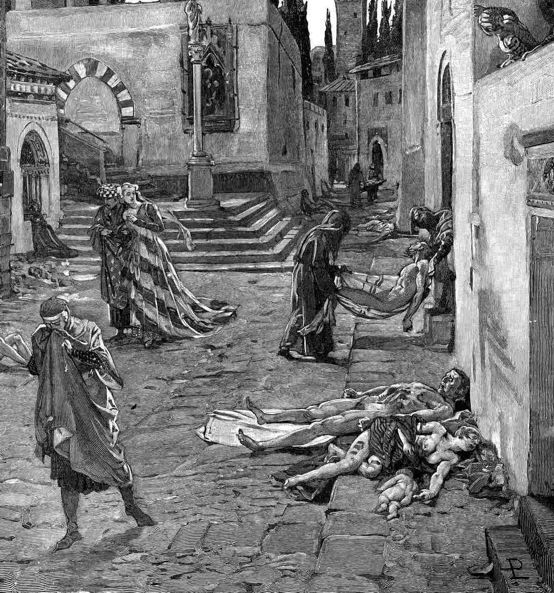
The whole world will remember 2020 as a sad year, marked by the Covid-19 pandemic to which, for Gaume, we must add the African swine fever epizootic, affecting wild boars, and which prevented access to forests.
Fortunately, our time benefits from effective means to counter these viruses, at least the current state of medicine makes it possible to limit the damage.
But in the Middle Ages and at the beginning of Modern Times, epidemics caused many more deaths.
At the time, medical theory ignored the mechanism of the spread of plague and hygiene was far from perfect, which favored the transmission of the disease.
After a first attack around 1350, the "black plague" again reached our regions in the 17th century and, in particular, the year 1636 was called the year of the "great mortality".
The population was decimated and even almost wiped out in a large number of localities in our regions.
It is said that nearly 380 Belgian hamlets and villages disappeared altogether during that year, like the village of Landin, the current "railway station district" of Sainte-Marie-sur-Semois.
Landin was indeed a village in its own right at that time, but we read in the parish registers of 1637 of Sainte-Marie: "Today, I buried the last bourgeois of Landin, decimated by the plague."
Landin was almost "wiped off the map".
Let's go back to that time
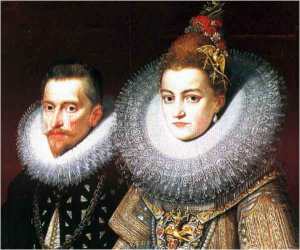
After the abdication of Charles V in 1555, the dynasty was split into two branches: the Spanish part, including the Netherlands (and therefore our region), under the reign of Philippe II, son of Charles V, and the Austrian part, managed by his uncle.
After Philippe II, the "Spanish Netherlands" benefited from specific rulers, the archdukes Albert and Isabella, who reigned between 1598 and 1621, still depending on Spain, but enjoying great autonomy.

In 1621, the Netherlands came back under the full domination of Spain and power became absolute again.
The kings of Spain rule the Netherlands from a distance and are represented by poorly qualified governors. After the truce of Archdukes Albert and Isabella, the war resumed and, from that moment, Belgium became, for nearly a century, the battlefield of Europe.
In particular, the Thirty Years' War (1618-1648) between the Habsburgs of Spain and the German Protestants, united with France, plunges the county of Chiny (and therefore still our region) in an abyss of misfortunes and calamities.
To this context of war is added the "black plague".
As highlighted by Julien Loiseau , the plague of the fourteenth and seventeenth centuries has two forms: a pulmonary form that resembles the coronavirus, except that when it is triggered in the Middle Ages, it is systematically deadly.
The other form, bubonic plague, is very spectacular because it is visible on the body, but it is not always fatal.
The other very important fundamental difference is the mode of transmission.
Certainly, in the case of the pulmonary form of plague, there is human-to-human transmission through postilions or soiled tissues, but otherwise it is absent in most cases.
Transmission is through the flea which, when the rats die, changes carriers and transmits the bacillus.
We too often forget that globalization is a very old process, which has experienced acceleration phases in history.
However, the role of trade links, and in particular maritime links, was decisive in the spread of the plague from the 14th century.
The mode of transmission of plague, by the black rat flea, favors this.
We know that the black rat was very present in the 14th century on European territory.
It is a species that is sedentary and only moves because humans move it.
And it is more than likely that the bacillus yersinia pestis , responsible for the plague, came from China. Well, well ...
And what we called "plague" at the time is probably a set of diseases: the different forms of plague were accompanied by cholera, typhus, ...
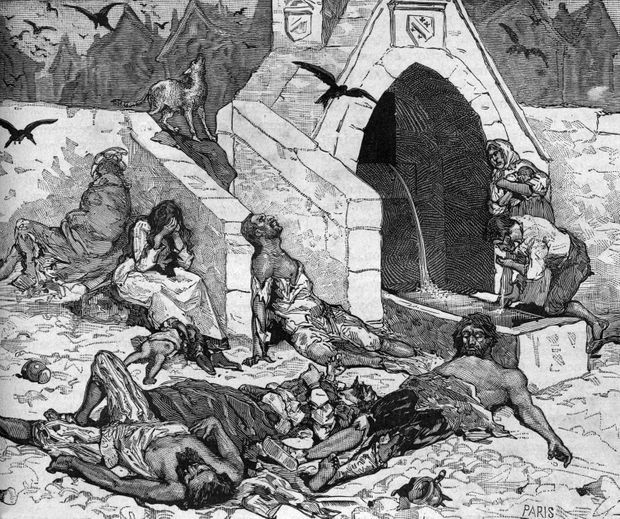
The current province of Luxembourg was particularly devastated. The plague was particularly rife in the towns, notably in Arlon and Virton, where the country people coming to seek shelter, fed it.
In Virton, the number of bourgeois was reduced from 210 to 49 and the number of victims rose to 2,500 people.
There died well 50 people a day.
The population of our province was reduced by more than two thirds.
In the reports of the Provincial Council, we can read
"We see the poor peasants of the countryside mate with the plows, and in the churches to make marriages between those who had escaped death, independently from noble to commoner, from poor to rich, so that the the year was called the "foolish year". "
According to Ed. Liégeois, in "Histoire de Tintigny" (1920), the terrible epidemic raged from around Quasimodo (the Sunday after Easter) until the beginning of the following October.
But when the plague ended, its dire consequences inevitably lingered for a long time to come.
During the years 1635-1636, the villages of Termes, Frenois, Moyen, La Cuisine, Martué, Villers-sur-Semois, Buzenol, Mortinsart, Nantimont are cited as totally abandoned.
Likewise, "because of wars and mortalities" the statements of civil causes in the registers of the time, for 1636 and 1937, indicate "nil" to all the receipts for the above villages as well as for Chiny, Lochenol ( Rossignol), Florenville and Estalle.
In the general calamity, Vance certainly also suffered greatly from the misery of the times, but it seems that his fate was less dire and that at no time was he totally deserted.
It even seems to result from a document of the time that its population had remained relatively large.
As for Buzenol, after the plague, according to Tandel, the locality being depopulated, the reigning prince then called from outside inhabitants to live in Buzenol.
According to the old people, the newcomers were Brabançons; they were numerous and able to face those from Buzenol whom the plague had spared.
Some discussions broke out. Finding nothing better, the natives threw in the face, to foreigners, the epithet of "Brabounnerie", an epithet which has been preserved to this day.
The local toponymy and the legends recall this sad time.
Thus, at a place called "Fontaine des Malades" (Fountain of the Sick), near Vance, an abundant spring gushes out, forming a fountain, to which, according to a tradition which has been passed down, we lead the seriously ill in times of plague epidemic, to look after them and especially to keep them away from the village.
Huts or cabins were established here, certainly because of the proximity of the water, in which were sheltered those who were considered to be helplessly lost and who lived there their last moments.
In Virton, the plague was so violent that it gave rise to a procession which was still taking place not long ago in the former capital of the Duchy, on the 26 Sunday in September.
Legend has it that Saint Roch, passing through Harnoncourt in times of epidemic, was struck by the plague.
He washed in a fountain, healed himself and imparted a miraculous virtue to the spring water which now bears his name.
He is often considered everywhere as a "healer of the plague".
In this "general calamity", did Landin suffer more than the other villages?
The Landin district currently groups at most a good twenty houses.
It is likely that in the 17th century there were still much less.
At a time when we are moving towards the regrouping of municipalities, it is difficult to imagine that Landin was a village in its own right.
Before becoming individual, Landin had to be an integral part, like Fratin, of the "ban" of Sainte-Marie: in 1602 the peasants of Landin benefited from the same uses as the bourgeois of Sainte-Marie in the woods called the Bois d'Etalle and Sainte-Marie.
At the time of feudalism, Landin, like Fratin, were considered as "outbuildings" (hamlets) of the seigneury of Sainte-Marie "bordering the mire of the streams of Gilbaupont and Le Plane".
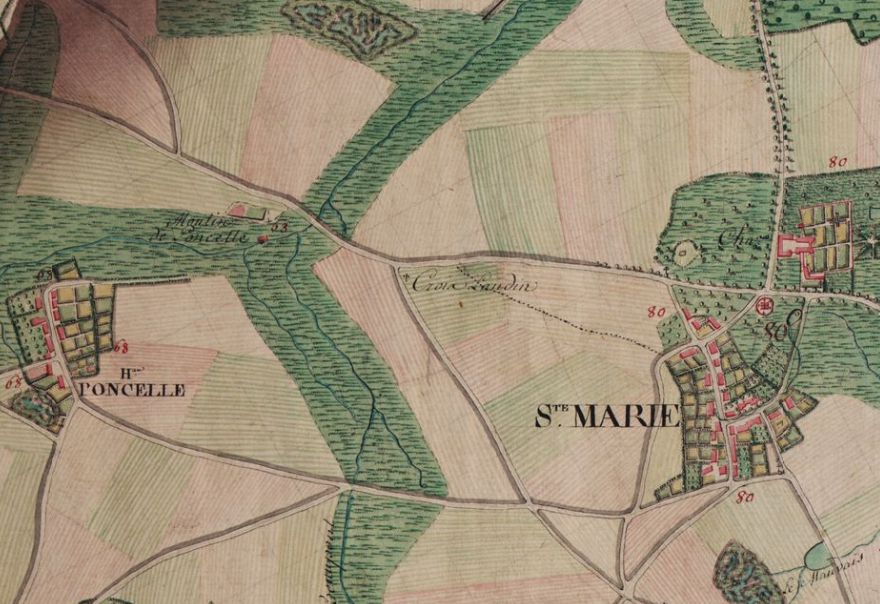 In any case, Ferraris' map, dating from 1777, does not indicate any buildings.
The only mention which is made between Poncelle and Sainte-Marie is the "cross of Landin", precisely erected in commemoration of the plague of 1636.
In any case, Ferraris' map, dating from 1777, does not indicate any buildings.
The only mention which is made between Poncelle and Sainte-Marie is the "cross of Landin", precisely erected in commemoration of the plague of 1636.
All the villages of the current municipality of Etalle have probably suffered in an equivalent way,
but Landin being very sparsely populated, the Black Death completely devastated it, leaving none of its inhabitants alive.
What was the population of Landin at the time?
According to Lepage, in any case, there was no one left in Landin in 1445.
Then the village saw an increase in the number of its peasants which went from three conduits paying the guards in 1459 to four in 1502 then nine in 1541
(the "conduit" is a tax unit corresponding to an entire plow, so it cannot be identified with a household) .
Tandel writes in 1890:
"Formerly the village of Sainte-Marie had two outbuildings: Fratin and Landin, almost as populous as the other.
By consulting the old parish records, Sainte-Marie could count around 250 inhabitants, Fratin 150 and Landin 200.
As a result of the plague of 1636 the village of Landin was almost completely destroyed; only a few people survived this terrible scourge.
In 1642, the old parish acts no longer mention this village. Currently we still find on the site where was built, a little above, the railway station of Sainte-Marie, some vestiges of its existence, such as stones, bricks, etc. "
One can however doubt the figures advanced by Tandel, since Balter writes, in a more precise way:
"This village was located between Sainte-Marie and Poncel, near the railway station.
It already existed as a village in 1270.
An enumeration carried out in the provôté d'Etalle in 1602 specifies as inhabitants six bourgeois and two widowed women:
to know 1. Gilles the manant, sergeant; 2. Gilles le petit Henry; 3. Henrion Crupin; 4. Jeannin, son of little Henry; 5. Jean Mathié; 6. Jean le grand Gilles; 7. Jeannette d'Etale; 8. Lienne, widow. "
And in 1637, the "last bourgeois of Landin" buried by the priest was Jean le Petit Gilles de Landin, probably a son of the "great Gilles".
It therefore seems quite clear that this small hamlet was decimated by the plague of 1636 by contagion between the few people who lived there.
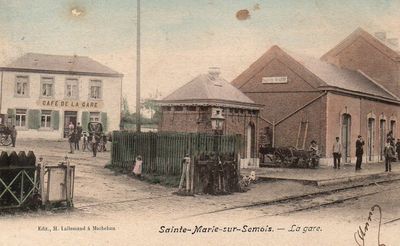
It does not matter, anyway: it was a heavy debt to pay for Landin, as for all the other villages.
Fortunately, Landin has recovered well since, with the Poncelle mill, which has become the Landin sawmill operated by the Stiernon family,
then opposite, the Dussard sawmill, also taken over by the Stiernon family.
Adelin Dussard also had a luxurious villa built which still exists in Landin.
The district also benefited from the installation of the Marbehan-Virton railway line, with the construction of the station in 1873,
and then, a little later, the tram stop in front of the station.
Like any self-respecting railway station district, he also owned a "station café", run by Louis Moreau, then by his son Marcel, who ran the bistro which then went through hours of glory.
Currently, it is the Karaquillos, still alive and well and renowned in the region.
Other than the "Landin's cross", at the foot of a remarkable purple beech, the black plague of 1636 is no more than a distant bad memory ...
Bibliography
- Tandel, E. Les communes luxembourgeoises. Tome III - L'arrondissement de Virton.- Annales de l'Institut Archéologique du Luxembourg - Arlon - tome 23 - 1890
- Balter, V. Localités disparues dans la province de Luxembourg.- Bulletin trimestriel de l'Institut Archéologique du Luxembourg - Arlon - 23e année - 1947
- Massonnet, J. Histoire de Chassepierre. - Annales de l'Institut Archéologique du Luxembourg - Arlon - tome 84 - 1953
- Massonnet, J. Histoire de Vance. - Annales de l'Institut Archéologique du Luxembourg - Arlon - tome 90 - 1959
- Lepage, D. Le lignage et la seigneurie de Sainte-Marie-sur-Semois. - Annales de l'Institut Archéologique du Luxembourg - Arlon - tomes 128-129 - 1997-1998